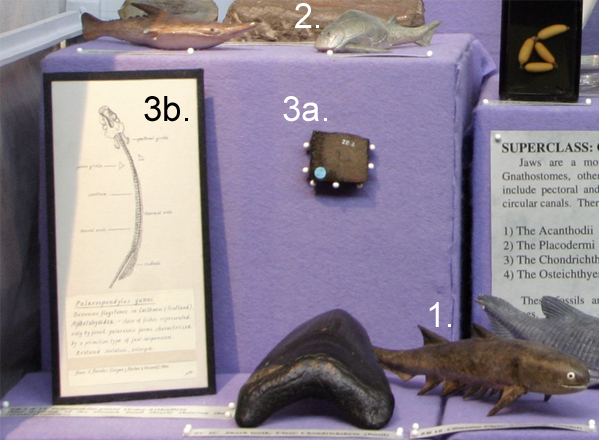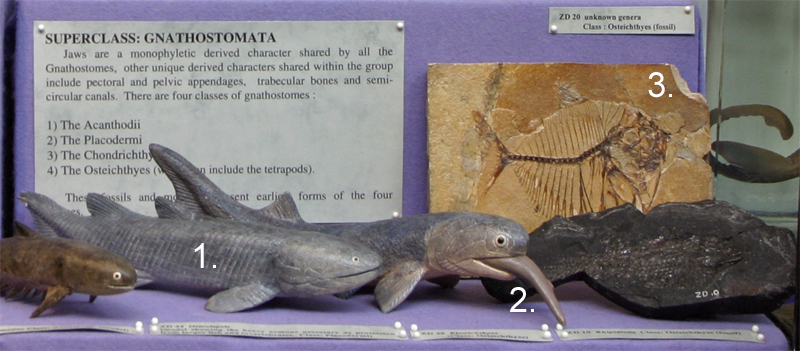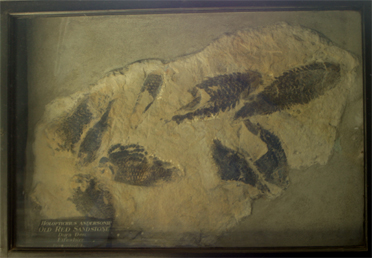
EXTINCT FISH
EXTINCT JAWLESS FISH
The first recorded jawless fish, known collectively as ostracoderms – i.e. shell-skinned, lived between 500 – 360 million years ago (mya). Ostracoderms had a bony armour, an internal cartilaginous skeleton and a heterocercal tail. Most lacked paired fins. The first recognizable lamprey was recorded in the Carboniferous period ( 325-380 mya). Although similar to modern lampreys, the relation of ostracoderms to living lampreys is unclear.
Reconstruction of Pteraspis sp. shows a finless ostracoderm, that lived in the Lower Devonian period (360 - 408 mya). |  |
Cephalaspids were unusual ostracoderms in possessing pectoral fins. A fossil shows they were essentially nothing more than a large food-straining gill chamber with a swimming tail, nerves and sense organs. They lived from the Lower Devonian to the late Silurian (360 – 438 mya). |  |
EXTINCT JAWED FISH: ACANTHODIANS AND PLACODERMS
The first group of jawed fish to appear in the fossil record around 440 mya were the acanthodians. Commonly called ‘spiny sharks’, fish such as Climatius were small, large eyed, scaled fish. They had stout ornamented spines in front of all their fins and two rows of paired ventral fins. Acanthodians were plankton feeders living in marine and fresh-water habitats. Their relations to other fish is controversial. Certain features suggest they were an offshoot of bony fish; other features suggest that they were more closely related to cartilaginous fish. The second group of jawed fish, the Placoderms (plate-skinned), lived between 360 – 440 mya. They were bottom-dwellers with jaws that developed from the first gill arch and enabled them to prey on other animals. Placoderms appeared at the time when ancestors of modern groups would be expected to occur but show little evidence of being these ancestors.

1. A model of Climatius - an acanthodian - in life only 3 inches (8 cm) long.
2. Reconstruction of Pterichthyes - an antiarch. In this group of placoderms, the anterior end was enclosed in box plates. These fish are presumed to have crawled around on mud and rocks using their fins which were also enclosed in plates.
3. Palaeospondylus gunni is a tiny fossil animal (3a.) from a Middle Devonian (360 - 408 mya) quarry in Scotland. Its identity is unclear: some suggest it is a larval form of a contemporary fish; others that it is a jawless fish or perhaps a placoderm without armour. An actual fossil shows the tiny size (1.5 cm); the drawing by M. Ramult (3b.) shows the structure.
BONY FISH AND THE ANCESTORS OF THE TETRAPODS
The different lineages of jawed bony fish that were ancestors of the modern teleosts, of the relict fish that exist today and of the tetrapods appeared in the Devonian period (360 – 408 mya).

1. Reconstruction of Osteolepis. Osteolepis was a very primitive lobe-finned fish only 30 – 60 cm in length belonging to the subclass Sarcopterygii, order Crossopterygii, suborder Rhipidistia. Its teeth were small and it is presumed to have fed on small invertebrates in the fresh waters where it lived. Heavy armour protected it against predation by very large fish and marine invertebrates. Such fish were common in the late Devonian seas (290 – 360 mya) and members of the stock that gave rise to land vertebrates. Most were extinct by the Permean (240 – 290 mya), their only relicts are three genera of tropical lung fish and the coelacanth.
2. Reconstruction of Elonichthys. This fish was an early member of a group of ray-finned fish (subclass Actinopterygii, infraclass Chondrostei) from the upper Permean of which only the sturgeons, paddle fish and bichirs survive. Assigned to its own order and family (order Palaeonisciformes, family Elonichthyidae), Elonichthys possibly represents the type of fish that gave rise to the teleosts.
3. A fossil of an unidentified bony fish. This fossil clearly shows the complex skeleton of early bony fish.
 Holoptychius andersoni, Upper Devonian fossils from Old Red Sandstone, Dura Den, Fifeshire. These fish were a primitive lineage of sarcopterygians, with deep bodies about 30 cm long, long fins, short broad heads and small eyes. They may have been ambush predators, like modern pikes, lying in wait for smaller fish and catching them with a forward lunge.
Holoptychius andersoni, Upper Devonian fossils from Old Red Sandstone, Dura Den, Fifeshire. These fish were a primitive lineage of sarcopterygians, with deep bodies about 30 cm long, long fins, short broad heads and small eyes. They may have been ambush predators, like modern pikes, lying in wait for smaller fish and catching them with a forward lunge.






